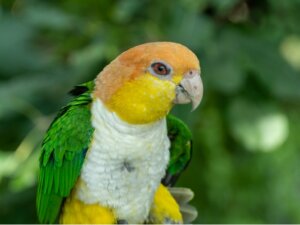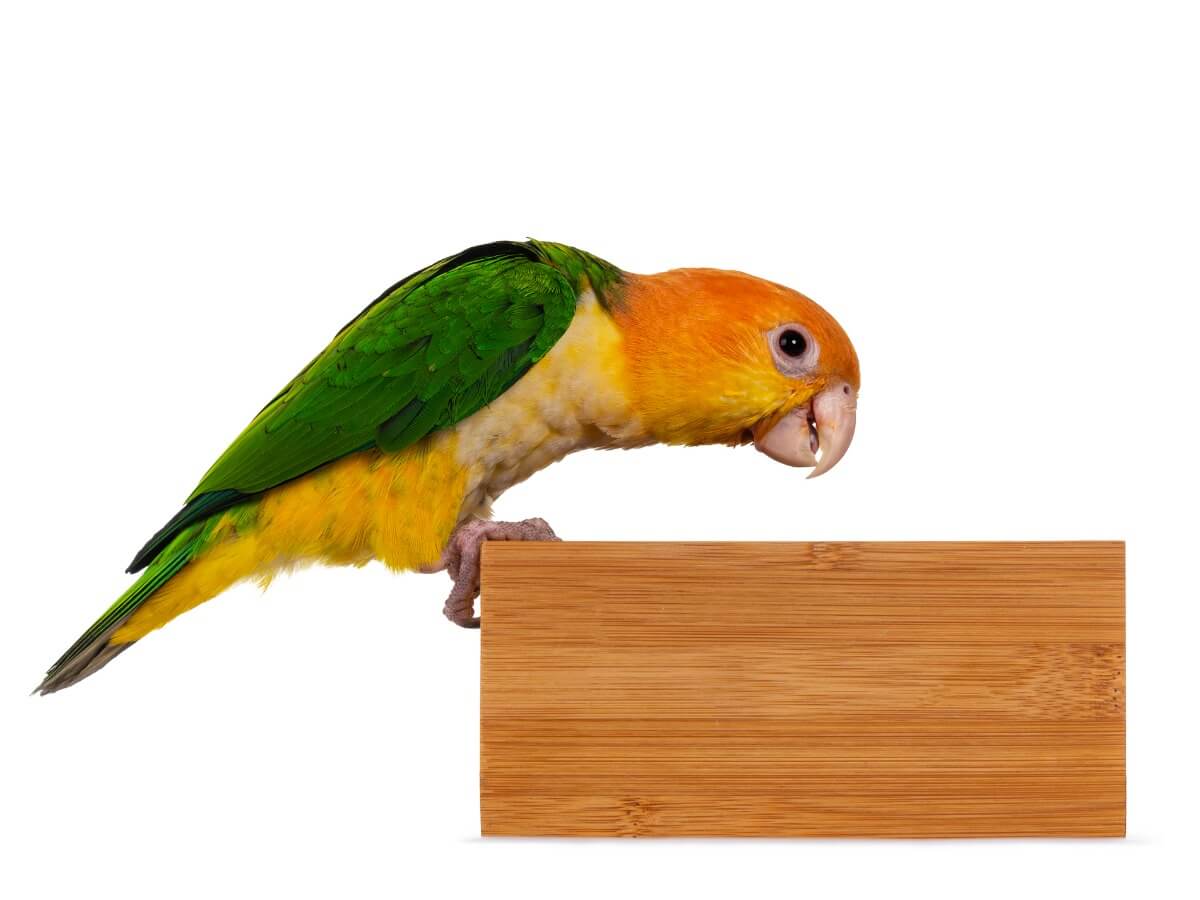Caiques: Everything You Need to Know


Reviewed and approved by the biologist Samuel Sanchez
Caiques are birds that belong to the genus Pionites and are characterized by being visually very attractive specimens. The genus brings together two species that are differentiated by the colors on their head and belly. They’re usually kept as pets thanks to their small size, as this facilitates their care.
They’re very intelligent birds, with unique, showy behavior and they aren’t as noisy as common parrots. Therefore, either of the two species of caique is an ideal option for those who want a colorful, playful, fun bird that isn’t very dependent on the owners. Below, you’ll find all the information you need to know about these beautiful animals.
Habitat of the caiques
The distribution of caiques covers a wide territory in South America. They’re divided between Guyana, southern Colombia, northern Venezuela, and a vast part of Brazil. In these countries, black-headed caiques (Pionites melanocephalus) tend to abound, while in southern Ecuador, northern Peru, and Bolivia, you’ll find white-breasted caiques (Pionites leucogaster).
The black-headed caiques inhabit the northern part of the Amazon River. On the other hand, the white-breasted caiques prefer the lower areas to the south of the same river. Due to its short flight capacity, you’re unlikely to find other populations in other regions bordering the riverbed.
Caiques have a small but heavy body and their short wings prevent them from traveling long distances. Consequently, their natural habitat fails to expand.

Physical characteristics
Physically, caiques are relatively small in size, about 23 to 25 centimeters (9 – 10 inches) in length. As mentioned above, the genus Pionites encompasses two species of caiques. Both are distinguished by the colors in their plumage. For example, the black-headed caique is characterized by its thighs and the lower part of the tail being orange and the belly being white.
In contrast, white-breasted caiques have an orange head, while the thighs and lower part of the tail have yellow tones. Also, its nape is a little paler and its belly (despite being white, as its name implies) sometimes also has yellowish tones. The wings of both species are usually green.
In both species, young birds have a strong yellow color on their belly that gradually becomes lighter.
These differences in the plumage of the caiques don’t give them sexual dimorphism, as the males and females are physically the same. The way to find out the sex of these birds is through observation, since the females are usually a little smaller than the males. However, this isn’t always the case, so DNA sexing is the most recommended option.
Behavior of caiques
Caiques are funny birds with a high level of sociability. They’re very popular as pets (especially black-headed caiques), although they can be quite noisy. These birds have a high-pitched, piercing screech that they emit at dawn and in the evenings.
Some breeders recommend acquiring a pair, as a single specimen has a greater chance of becoming more dependent on the owners. Interestingly, caiques have been observed to give off a peculiar odor that can be described as a cardboard-like scent. The intensity of this aroma depends on the bird’s diet, genetics, or emotional state.
Feeding the caiques
Caiques are characterized by being very gluttonous birds, and they can eat more food compared to other larger birds. They have a very high metabolism, so they are very active and consequently need a large amount of food at their disposal.
Interestingly, these birds aren’t prone to obesity and don’t have special food requirements. On the contrary, their diet is very simple and, in captivity, it’s based on fruits such as apples, oranges, and grapes. These animals are also lovers of sunflower, wheat, birdseed and hemp seeds.
In the wild, caiques don’t eat fruit, because, in reality, they only squeeze the fruits and extract the juice from them. However, although their diet isn’t complex, you do need to feed that large amounts on a regular basis. Despite having diurnal habits, some caiques also decide to eat at night.
Reproduction of caiques
As for the reproduction of these birds, the courtship season varies depending on the territory in which they live. In Venezuela, it begins in mid-April, while in Suriname it takes place in October. Females lay about 3 eggs on average, which are incubated for 26 days to later hatch. The life expectancy of this species is 15 to 20 years.
Caique pet care
These birds don’t need much care apart from a good area where they can exercise and constant food. Because their natural habitat is tropical, caiques tolerate temperatures between 33ºC and 42ºC, but they do not respond well to extreme cold. If they’re kept as pets in Europe or very cold places in winter, they should be given shelter.
Regarding the measurements of the cage, it can be 1.50 meters long by 1 meter high and another meter wide. These dimensions are necessary, due to the playful and active behavior of caiques. However, it’s important for the bars to be no more than 2 centimeters apart (0.8 inches), as this prevents the bird from escaping.
Toys should also be added to the cage for the birds to have fun. Emotional stimulation is very important in these birds.
https://www.youtube.com/watch?v=u-pIhhlQh9Q
As you can appreciate, caiques are a very curious and active species that need simple care to live comfortably in captivity. Its beautiful plumage and small size make this bird an ideal specimen for those who want an exotic bird as a pet.
Caiques are birds that belong to the genus Pionites and are characterized by being visually very attractive specimens. The genus brings together two species that are differentiated by the colors on their head and belly. They’re usually kept as pets thanks to their small size, as this facilitates their care.
They’re very intelligent birds, with unique, showy behavior and they aren’t as noisy as common parrots. Therefore, either of the two species of caique is an ideal option for those who want a colorful, playful, fun bird that isn’t very dependent on the owners. Below, you’ll find all the information you need to know about these beautiful animals.
Habitat of the caiques
The distribution of caiques covers a wide territory in South America. They’re divided between Guyana, southern Colombia, northern Venezuela, and a vast part of Brazil. In these countries, black-headed caiques (Pionites melanocephalus) tend to abound, while in southern Ecuador, northern Peru, and Bolivia, you’ll find white-breasted caiques (Pionites leucogaster).
The black-headed caiques inhabit the northern part of the Amazon River. On the other hand, the white-breasted caiques prefer the lower areas to the south of the same river. Due to its short flight capacity, you’re unlikely to find other populations in other regions bordering the riverbed.
Caiques have a small but heavy body and their short wings prevent them from traveling long distances. Consequently, their natural habitat fails to expand.

Physical characteristics
Physically, caiques are relatively small in size, about 23 to 25 centimeters (9 – 10 inches) in length. As mentioned above, the genus Pionites encompasses two species of caiques. Both are distinguished by the colors in their plumage. For example, the black-headed caique is characterized by its thighs and the lower part of the tail being orange and the belly being white.
In contrast, white-breasted caiques have an orange head, while the thighs and lower part of the tail have yellow tones. Also, its nape is a little paler and its belly (despite being white, as its name implies) sometimes also has yellowish tones. The wings of both species are usually green.
In both species, young birds have a strong yellow color on their belly that gradually becomes lighter.
These differences in the plumage of the caiques don’t give them sexual dimorphism, as the males and females are physically the same. The way to find out the sex of these birds is through observation, since the females are usually a little smaller than the males. However, this isn’t always the case, so DNA sexing is the most recommended option.
Behavior of caiques
Caiques are funny birds with a high level of sociability. They’re very popular as pets (especially black-headed caiques), although they can be quite noisy. These birds have a high-pitched, piercing screech that they emit at dawn and in the evenings.
Some breeders recommend acquiring a pair, as a single specimen has a greater chance of becoming more dependent on the owners. Interestingly, caiques have been observed to give off a peculiar odor that can be described as a cardboard-like scent. The intensity of this aroma depends on the bird’s diet, genetics, or emotional state.
Feeding the caiques
Caiques are characterized by being very gluttonous birds, and they can eat more food compared to other larger birds. They have a very high metabolism, so they are very active and consequently need a large amount of food at their disposal.
Interestingly, these birds aren’t prone to obesity and don’t have special food requirements. On the contrary, their diet is very simple and, in captivity, it’s based on fruits such as apples, oranges, and grapes. These animals are also lovers of sunflower, wheat, birdseed and hemp seeds.
In the wild, caiques don’t eat fruit, because, in reality, they only squeeze the fruits and extract the juice from them. However, although their diet isn’t complex, you do need to feed that large amounts on a regular basis. Despite having diurnal habits, some caiques also decide to eat at night.
Reproduction of caiques
As for the reproduction of these birds, the courtship season varies depending on the territory in which they live. In Venezuela, it begins in mid-April, while in Suriname it takes place in October. Females lay about 3 eggs on average, which are incubated for 26 days to later hatch. The life expectancy of this species is 15 to 20 years.
Caique pet care
These birds don’t need much care apart from a good area where they can exercise and constant food. Because their natural habitat is tropical, caiques tolerate temperatures between 33ºC and 42ºC, but they do not respond well to extreme cold. If they’re kept as pets in Europe or very cold places in winter, they should be given shelter.
Regarding the measurements of the cage, it can be 1.50 meters long by 1 meter high and another meter wide. These dimensions are necessary, due to the playful and active behavior of caiques. However, it’s important for the bars to be no more than 2 centimeters apart (0.8 inches), as this prevents the bird from escaping.
Toys should also be added to the cage for the birds to have fun. Emotional stimulation is very important in these birds.
https://www.youtube.com/watch?v=u-pIhhlQh9Q
As you can appreciate, caiques are a very curious and active species that need simple care to live comfortably in captivity. Its beautiful plumage and small size make this bird an ideal specimen for those who want an exotic bird as a pet.
All cited sources were thoroughly reviewed by our team to ensure their quality, reliability, currency, and validity. The bibliography of this article was considered reliable and of academic or scientific accuracy.
- Gonzales, F. Caiques. AFA Watchbird, 23(2), 45-46.
- Marshall, T. C. Captivating Caiques. AFA Watchbird, 22(2), 8-9.
- Marshall, T. C. Caiques: A Superspecies. AFA Watchbird, 41(4), 6-9.
- Lima, R. The Care and Breeding of Caiques. AFA Watchbird, 23(2), 34-38.
This text is provided for informational purposes only and does not replace consultation with a professional. If in doubt, consult your specialist.








